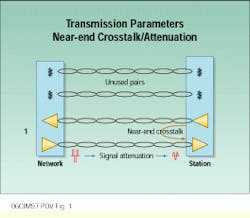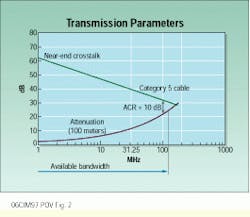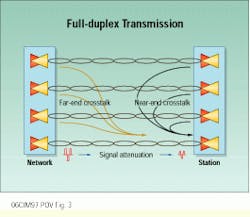Paul Kish
Nordx/CDT
Today, the telecommunications industry has standardized on Category 5, 100-ohm unshielded twisted-pair (utp) cabling as the preferred medium for local area network and data applications in commercial buildings. The transmission of 100 megabits per second over twisted-pair/physical media-dependent 100Base-T, and 155 Mbits/sec over Asynchronous Transfer Mode (atm) is commonplace in the industry. Computer manufacturers and chip vendors are striving to increase networking speeds to promote the use of more-powerful computers for more-powerful applications--for example, mpeg-2 full-motion video and three-dimensional graphics emulation.
Switchable 100Base-T/10Base-T network cards can be purchased for approximately $99. These cards can operate at either 100- or 10-Mbit/sec data rates, and it appears that 100Base-T will soon displace 10Base-T as the base network platform for desktop applications. Meanwhile, the ieee 802.3 committee of the Institute of Electrical and Electronics Engineers (ieee--New York, NY) is aggressively developing a standard for 1000 Mbits/sec, or 1000Base-T, with the objective of making it work over the installed base of Category 5 cabling.
This gigabit data rate is attracting much attention. Equipment vendors are trying to make it happen sometime in 1998. A gigabit data rate will provide considerable information-carrying capacity, which will initially be used to relieve backbone traffic congestion. It is also likely that 1000Base-T will become the next platform for desktop applications in five to ten years.
The protocol for 10Base-T Ethernet was developed to work over Category 3 cabling. Only five years ago it was difficult to get network equipment vendors to recognize the need for higher-performance cabling than that. Today, the performance of Category 3 cabling tops out at 100 Mbits/sec and calls for the use of expensive and sophisticated electronics--for instance, in 100Base-T4. The current norm is 100 Mbits/sec using Category 5 cabling and simple electronics--for example, 100Base-Tx.
We are now in much the same position as we were five years ago with 10Base-T. More than 60% of existing buildings are already wired with Category 5. Equipment vendors still do not recognize the need for higher-performance cabling beyond the installed base of Category 5. Most network equipment vendors are interested in manufacturing and selling black boxes. The need for special cabling would restrict the market for black boxes because recabling is perceived to be too expensive--and after all, 1000Base-T can work over generic Category 5 cabling.
Many people in the cabling industry think that the performance of generic Category 5 cabling will top out at 1000 Mbits/sec. Today, we need a new category of cabling that is well-positioned for the next generation of networking speeds, that can easily support 1000 Mbits/sec using simple electronics, and that can become the installed base of the future. This new category of cabling needs to be backward-compatible with all existing Category 5 applications and needs to be recognized and standardized in the industry.
Enhanced cabling
We know more about cabling today than we did five years ago. Many vendors are advertising higher-performing cables and, to a lesser extent, enhanced-performance connecting hardware and patch-cord assemblies that exceed the minimum Category 5 specification. These performance improvements are being marketed aggressively by manufacturers to differentiate their products.
Such information tends to be qualitative rather than quantitative. Published results look impressive, but when carefully analyzed, they show only typical, nominal, or ninetieth-percentile values. For example, sometimes channel results are shown when tested from one end of the cable only, excluding the effect of the modular 8-pin plug/jack connection--often the weak link in the system. These results are also indicative of laboratory measurements and do not necessarily apply to the cabling after installation, where additional variables can be introduced.
It is unlikely that there are any adequate guarantees after installation for performance beyond the Category 5 level. Also, most field testers cannot yet verify accurately any extended-frequency performance claims, although this situation may change in the near future.
So, what are end-users actually getting when they purchase an enhanced cabling component? Most likely, there will be some qualitative improvement in performance at 100 MHz, such as additional margin, or attenuation-to-crosstalk ratio (acr). There may also be some additional bandwidth beyond 100 MHz.
It is difficult, if not impossible, to estimate how much additional bandwidth is provided, unless the components are tested together as a system in a worst-case configuration. Testing components in an end-to-end channel configuration, for example, can reveal performance deficiencies due to improper plug-cord terminations and impedance mismatch effects between components.
To take advantage of the better transmission characteristics of enhanced cabling, the equipment designer needs to know the expected performance of a worst-case channel over the frequency bandwidth of interest. Also, the designer may require additional transmission parameters that are not specified today for Category 5 cabling but will be important for future high-speed networks. These parameters include propagation delay and delay skew, as well as the combined power-sum crosstalk resulting from both near-end and far-end crosstalk in the cabling.
The TR-41.8 subcommittee of the Telecommunications Industry Association (tia--Arlington, VA) has formed a study group to develop specifications and test methods for enhanced-performance, twisted-pair cabling systems. In developing these requirements, the study group will take into account
- the requirements of future applications such as 1000Base-T,
- input from applications standards groups,
- a superset of current 4-pair Category 5 cabling,
- alternatives other than utp, such as screened and shielded twisted-pair,
- stability of shielding performance and shield integrity,
- a better cable model for near-end and far-end crosstalk, noise, and balance,
- the effect of differential and common-mode terminations,
- accurate test methods extending up to 300 MHz and higher.
The study group is also expected to develop field-test specifications for copper backbone cabling.
The scope of the work to be done by the tia also includes
- study of transmission performance as it applies to end-to-end channel configuration, including connectors and patch cords as specified in telecommunications systems bulletin (tsb)-67,
- priority to be given to complete Category 5 specifications,
- compliance with Federal Communications Commission (fcc--Washington, DC) regulations and the EN-50022 class A and B requirements of the European Community.
The tia`s TR-41.8.1 working group recognizes that more work remains to be done to complete the specifications for Category 5 cabling. In fact, the tia`s utp systems task group is already working on a straw-man document that will include transmission parameters such as return loss and equal-level far-end crosstalk performance for a channel. Both of these parameters are needed to support 1000Base-T applications.
In addition, more work is needed to develop test methods and requirements for measuring the balance of a utp channel and utp components. This measurement is sensitive to the test configuration, the location of the cables relative to ground, the type of termination of cable pairs, and the balun characteristics. Once the test method has been developed and validated, it will be necessary to relate these measurements to the electromagnetic-compatibility requirements of the fcc, as well as EN-55022 and EN-55024.
The group will also address performance requirements for enhanced-performance cabling. At this time, the group says that if there is going to be a Category 6 specification, it needs to be a significant improvement over Category 5. It also needs to be a complete specification--not put together piecemeal. For example, the specification should address channel performance and not just component requirements.
One of the most important transmission parameters is the available bandwidth of a channel. For our purposes here, the maximum available bandwidth is defined as "the frequency at which the total noise (including near-end and far-end crosstalk, impulse noise, and other factors) is equal to the signal level at the receiver."
Most data systems today employ half- duplex transmission, in which one wire pair is used to transmit data while another pair is used to receive it. For such systems, Category 5 cabling has an available bandwidth that is limited by the worst-case, pair-to-pair near-end crosstalk to about 100 MHz.
Systems that use more than two pairs to transmit and receive data signals generate more noise. This additional noise can be taken into account by specifying the power-sum crosstalk resulting from combined near-end and far-end crosstalk. Four-pair utp cabling that meets power-sum Category 5 requirements has an available bandwidth of 200 MHz, when using all four pairs in half-duplex mode--that is, 100 MHz per two pairs.
The proposed Gigabit Ethernet, or 1000Base-T, standard will use full- duplex transmission, in which a given pair is used to both transmit and receive information simultaneously. Full-duplex systems make more-efficient use of the available pairs in a cable, but they are also more susceptible to additional noise caused by signal reflections. Four-pair utp cable that meets power-sum Category 5 requirements and appropriate return-loss specifications has an available bandwidth of 400 MHz. This involves using all four pairs in full-duplex mode, with 100 MHz transmitted per pair.
Although gigabit applications will be designed to work over Category 5 cabling using sophisticated digital-signal processing techniques, enhanced cabling will provide more margin and higher data throughput, as well as fewer errors, in a noisy environment.
Power-sum crosstalk
The operation of full-duplex parallel transmission over a channel composed of four twisted-pair cables involves dividing the data signal among four pairs and transmitting it through the cabling. At the other end, the four data streams are recombined to restore the original signal. Each pair is used for bidirectional data transmission between two transceivers. The transmit and receive signals are separated within the transceiver using a hybrid circuit.
However, a station that is receiving a data signal on pair 1 from the network is at the same time receiving near-end and far-end crosstalk interference from pairs 2, 3, and 4. The crosstalk interference is added using a power-sum formula and is calculated for each pair at both ends of the cabling. (A channel is considered to meet Category 5 power-sum near-end crosstalk requirements if the worst-pair power-sum near-end crosstalk meets the requirements currently specified for worst-case, pair-to-pair near-end crosstalk in tia/eia-568a, Annex E, and also tsb-67.)
In addition, the contribution of far-end crosstalk needs to be taken into account in the power-sum calculation. This crosstalk is currently not specified for Category 5 cabling.
A channel that is designed to meet Category 5 power-sum near-end crosstalk requirements and also appropriate power-sum far-end crosstalk requirements can provide an available bandwidth of at least 100 MHz per pair for applications using full-duplex parallel transmission. (Note that far-end crosstalk is length-dependent and makes a greater contribution at lower frequencies.)
In the last five years, we have seen rapid evolution of networking technology to encompass up to 100-Mbit/sec data transmission over Category 3 cables using complex coding and up to 155-Mbit/sec atm over Category 5 cabling using simple coding. Today, 100-Mbit/sec Fast Ethernet (100Base-Tx) over Category 5 cabling is well-positioned to overtake 10Base-T as the basic networking platform for desktop applications. Category 5 also has the potential of supporting gigabit applications such as 1000Base-T and 1.2-Gbit/sec atm. These applications will take full advantage of the available bandwidth of Category 5 or enhanced-performance Category 5 cabling, using all four pairs for full-duplex transmission.
There are many exaggerated claims regarding enhanced-performance Category 5 cables. Some cable-transmission parameters are specified up to 350 MHz or higher. The end-user should be aware that a "tested to 350 MHz" label does not equate to real bandwidth. Furthermore, what counts is the end-to-end system performance in a worst-case channel configuration. Testing components in a worst-case channel configuration can reveal performance deficiencies in modular plug-jack connections and mismatches of both impedance and balance between components.
In some cases, these deficiencies can limit the available bandwidth to a level not much above that of a Category 5 channel. Until an enhanced cabling standard is published, installed cabling should comply with power-sum Category 5 near-end crosstalk requirements for a worst-case channel. q
Paul Kish is senior manager for ibdn structured cabling systems and standards with nordx/cdt (St. Laurent, QC, Canada). He is the current chairman of the tia`s TR-41.8 subcommittee and a member of the bicsi Engineering Committee.
In a half-duplex transmission, one pair transmits data while the other receives it. Near-end crosstalk interference between the pairs in a cable is generated by a near-end transmitter, while the attenuation shows a decrease in signal level due to copper and material losses.
The transmission parameters show a difference between near-end crosstalk and the attenuation of the copper pair at various frequencies. Category 5 cables require a minimum attenuation-to-crosstalk ratio of 10 dB at 100 MHz.
A station receives a data signal on pair 1 from the network at the same time that it is receiving near-end crosstalk interference from pairs 2, 3, and 4 and far-end crosstalk interference from pairs 2, 3, and 4. The combined interference is added on a power-sum basis and called the combined power-sum crosstalk for pair 1.




